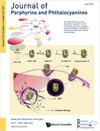伯胺作为三吡啶酮自由基配合物的配体和连接体
IF 0.9
4区 化学
Q4 CHEMISTRY, MULTIDISCIPLINARY
引用次数: 0
摘要
生物吡咯素色素是由血红素在生物环境中降解产生的,具有三个或两个吡咯环和特征的吡咯-2- 1末端。这些支架在配位化合物中充当氧化还原活性配体和电子储存器。三吡啶-1,14-二酮配位二价过渡金属作为承载离域自由基的二阴离子配体。在此,我们报道了钯(II)和铂(II)三吡啶酮配合物的合成和表征,该配合物在正方形平面几何的第四个配位位置具有伯胺(即苯胺,叔丁胺,1,2-乙二胺)。配体间氢键相互作用在配位胺和三吡啶酮支架上的羰基之间观察到。值得注意的是,1,2-乙二胺被用来连接两个Pt(II)三吡啶酮配合物。光学吸收和电子顺磁共振(EPR)光谱显示,所有得到的配合物都存在在室温和暴露于空气时稳定的配体基自由基。通过多中心相互作用的自旋配对导致[公式:见文本]-三吡啶酮自由基的二聚化和低温下EPR信号的减弱。电化学测量表明配体体系经历了准可逆的单电子氧化和还原,从而证实了三吡啶酮在三种不同的氧化还原状态下形成方形平面配合物的能力。本文章由计算机程序翻译,如有差异,请以英文原文为准。
Primary amines as ligands and linkers in complexes of tripyrrindione radicals
Biopyrrin pigments, which result from the degradation of heme in biological settings, feature three or two pyrrole rings and characteristic pyrrolin-2-one termini. These scaffolds serve as redox-active ligands and electron reservoirs in coordination compounds. Tripyrrin-1,14-dione coordinates divalent transition metals as a dianionic ligand hosting a delocalized radical. Herein, we report the synthesis and characterization of palladium(II) and platinum(II) tripyrrindione complexes featuring a primary amine (i.e., aniline, tert-butylamine, 1,2-ethylenediamine) at the fourth coordination site within square planar geometries. Interligand hydrogen-bonding interactions are observed between the coordinated amine and the carbonyl groups on the tripyrrindione scaffold. Notably, 1,2-ethylenediamine is employed to link two Pt(II) tripyrrindione complexes. As revealed by optical absorption and electron paramagnetic resonance (EPR) spectroscopy, all resulting complexes present ligand-based radicals that are stable at room temperature and when exposed to air. Spin pairing through multicenter interactions leads to [Formula: see text]-dimerization of the tripyrrindione radicals and a decrease in the EPR signal at low temperatures. Electrochemical measurements indicate that the ligand system undergoes quasi-reversible one-electron oxidation and reduction, thus confirming the ability of tripyrrindione to form square planar complexes in three different redox states.
求助全文
通过发布文献求助,成功后即可免费获取论文全文。
去求助
来源期刊
CiteScore
2.10
自引率
20.00%
发文量
62
审稿时长
1 months
期刊介绍:
The Journal of Porphyrins and Phthalocyanines (JPP) covers research in the chemistry, physics, biology and technology of porphyrins, phthalocyanines and related macrocycles. Research papers, review articles and short communications deal with the synthesis, spectroscopy, processing and applications of these compounds.

 求助内容:
求助内容: 应助结果提醒方式:
应助结果提醒方式:


